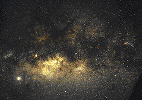 Our
whole solar system, together with the local stars
visible on a clear night, orbits the center of our home galaxy, the Milky
Way, a spiral
disk of 200 billion stars and their planets, and thousands of clusters and
nebulae. All these objects orbit their common center of mass called
the Galactic Center. Our Sun is one of the 200 billion stars of the milky
way and is located roughly 24,000 light years from the Galactic Center.
Our
whole solar system, together with the local stars
visible on a clear night, orbits the center of our home galaxy, the Milky
Way, a spiral
disk of 200 billion stars and their planets, and thousands of clusters and
nebulae. All these objects orbit their common center of mass called
the Galactic Center. Our Sun is one of the 200 billion stars of the milky
way and is located roughly 24,000 light years from the Galactic Center.
As a galaxy, the Milky Way is actually a giant, as
its mass is probably between 750 billion and one trillion solar masses,
and its diameter is about 100,000 light years. The Milky Way Galaxy belongs to the Local Group of
galaxies, a small group of 3 large and over 30 small galaxies, and is the
second largest (after the Andromeda Galaxy/M31) of this group. Andromeda is
also a spiral galaxy like the Milky Way but is 4 times as massive and is 2.9
million light years away. Andromeda is the nearest large galaxy, but
a number of faint galaxies are much closer: Many of the dwarf Local Group
members are satellites or companions of the Milky Way. The closest of all
is the Sagittarius Dwarf Elliptical Galaxy (SagDEG) at about 80,000 light
years from us and some 50,000 light years from the Galactic Center,
followed by the more conspicuous Large and Small Megallanic Clouds at
179,000 and 210,000 light years, respectively.
Our galaxy, one of billions of galaxies known,
is traveling through intergalactic space.
 The Pages of The Gray Wizard
The Pages of The Gray Wizard![]()